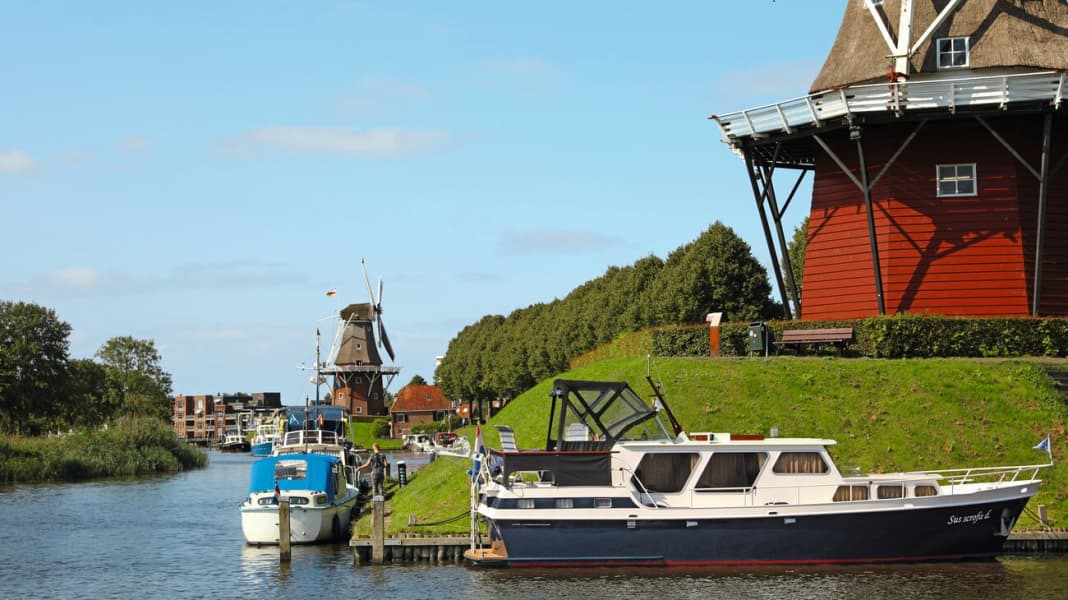
My skipper Manni, the one from the "Meckerecke", is not known for being a fusspot. But when his summary of our trip is: "There's nothing to complain about", that's an A with an asterisk and therefore worthy of a headline. Now he's even thinking about doing the same trip again with his daughters!
So: nothing to complain about. Even the charter base is ideal. Situated in the province of Groningen in Zoutkamp on the north bank of the Reitdiep, the boats from DHW-Charter "Heck zum Kai" are ready to cast off right in front of the Gruno shipyard. Your own car can be unloaded within a few metres of the stern of the boat. The shopping at the Spar supermarket in Dorpsstraat, just 200 metres away, can therefore be a little more generous. Everything is on board in no time at all.
After the kopje koffie met gebak, which is essential in the Netherlands, it's time to take over the boat. Diether Wilhelms, the German owner of DHW-Charter, presents us with "Arielle", a Gruno 33 S Explorer, which shows no sign of the 1400 hours of engine operation: I have rarely seen such a perfectly maintained lady in the Dutch charter business. Manni checks the technology and is also satisfied: "Nothing to complain about."

Fishing has been one of the town's most important industries for centuries. Of course: Zoutkamp was located directly by the sea, the Lauwerszee was a North Sea bay. The tide-free Lauwersmeer, which is connected to the town via the former Zoutkamperril and Reitdiep estuaries, was only created in 1969 when it was dyked.
The Old Harbour, just a few steps away from our berth, particularly captivates us. A harbour basin open to the south-west, wrested from the Reitdiep by a 160-metre-long dam, now offers wonderful moorings for pleasure craft. Several restaurants with a view of the harbour can be found on the Reitdiepskade, the landside boundary of the harbour. Right in the centre is a small fishing museum that brings the former livelihood of this small town to life.
Bright sunshine on our first day of sailing, Saturday, 4 September 2021. The fact that it's supposed to stay like this for a whole week is probably a belated compensation for a messed-up "summer" in the far north. So on this front too: nothing to complain about!
The first, but certainly not the last, movable bridge on our cruise towards Lauwersmeer is the Reitdiepbrug. As it is only 3.55 metres high when closed (we have 4.20 metres), we have to head for the reporting point on the tail unit and press a button to request the opening. This happens after a few minutes as if by magic. It's good to know how to do it and that it works, because we'll be playing this game several more times. We reach the southern part of the Lauwersmeer via the well buoyed channel of the Zoutkamperril. A few water sports enthusiasts and a tall ship from the "brown fleet" are on their way.

In the border area between the provinces of Groningen and Friesland, after around four kilometres we reach the well buoyed entrance to the Dokkumer Diep, which branches off to the south, and are now in Friesland. In Dokkumer Nieuwe Zijlen, the Lunegat marina offers comfortable moorings in the middle of nowhere. We turn our attention to the Willem Loré lock, which was a sea lock until the Lauwerszee was dyked, allowing shipping traffic to and from the Wadden Sea. Below the lock, we sail along the Dokkumer Grootdiep in "weekend sunshine". The pleasure craft traffic is correspondingly lively. In particular, the sloops that are so popular here are booming in this weather and are presented by their owners in the finest designs.
After almost five hours of travelling, we reach Dokkum. The lively little town is completely surrounded and criss-crossed by canals. We head south and head for the Zuidergracht canal. Here you can moor on both sides of the paved bank in front of water and electricity connections. But beware: the north side is reserved for sailing boats with a deeper draught. We have to go to the south bank and moor a hundred metres in front of the Woudpoortbrug. From here, it is only 250 metres to one of the most beautiful spots in the city centre: the bridge between the Groot- and Kleindiep, which has been widened into a viewing and relaxation platform. It's not just us who can relax here.
200 metres southwest of the Woudpoortbrug, another visual highlight of the city: the De Hoop corn mill at the transition between the Zuider and Baantjegracht canals, with the Zeldenrust mill in the background at the outlet of the Baantjegracht canal into the Dokkumer Ee. In between are plenty of moorings. It couldn't be more beautiful, and there's no better postcard. Corona is the mother of invention: the harbour fee of 13.25 euros can only be paid by card. The harbour master has mounted the card reader on a 1.50-metre-long board, which he holds out to the payer, keeping them at a distance. Incidentally, this is how it works in all the harbours we have visited during the pandemic.
Altenabrêge is the name of the first bridge in the Dokkumer Ee. Five euros are payable at this ultra-modern bascule bridge, which is collected in the traditional way with a clog (wooden shoe). This pays for all the bridges in Dokkum. Bascule bridge, windmill, bascule bridge, church: the Dokkumer Ee runs straight through the small village of Burdaard, providing another postcard view. On the mill side, there are plenty of moorings alongside the shore. Cosy town houses in the background. Here, too, you would like to stay longer.
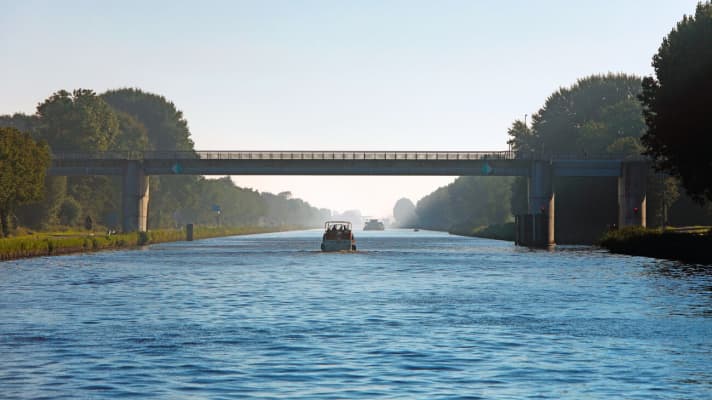
Two hours later, we are in Leeuwarden, capital of the province of Friesland and European Capital of Culture 2018. It's a shame to only have one afternoon and one evening for this city. Coming from the north on the Dokkumer Ee, the city's "harbour" stretches from the Noorderbrug to the south of the Vrouwenpoortsbrug over a distance of just over one kilometre. "Harbour" in "Tüddeln", because it is not actually a harbour, but the Noorder Stadsgracht, where you can moor on both sides of the fortified banks. If necessary, you can go alongside near a water and electricity connection. The fees of 19.10 euros charged here "with board" are a bargain for this location.
All hell is breaking loose on the canal. It seems as if all the owners in the city have refloated their boats because of the beautiful late summer day. Many hire boats are also out and about. Party atmosphere all round.
Moorings on the west bank are right next to the city park (Prinsentuin), an extremely popular destination for water sports enthusiasts and land tourists. On the south-western edge of the park stands the town's landmark: de Oldehove, the "leaning tower of Leeuwarden", so to speak. Shortly after construction began in 1529, it began to lean. This is how the not very attractive 39 metre high brick building became famous. It is currently almost two metres out of plumb, making it leaner than its fellow sufferer in Pisa. In summer, de Oldehove can be climbed via a staircase with 183 steps. The reward is a marvellous panoramic view of the city. The historic city centre south of the city park to the city canal and the Nieuwestad is well worth a visit.
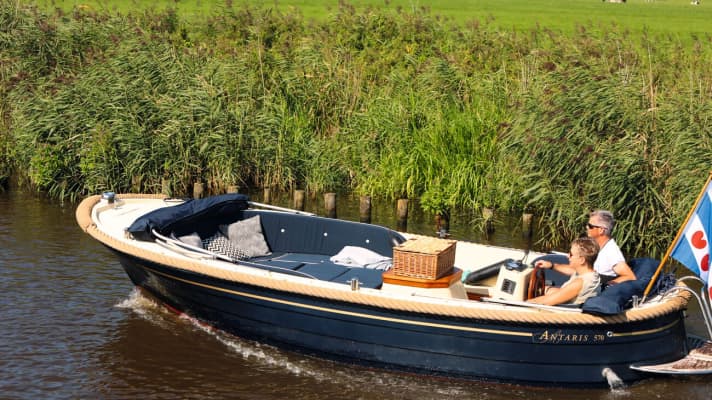
The Staande Mastroute (Standing Mastroute) towards Lemmer (IJsselmeer), on which we have been travelling since Zoutkamp, leaves Leeuwarden with an eye-catcher of a special kind: at the Slauerhoffbrug over the Harlingervaart, a 15 by 15 metre road plate is folded upwards and simultaneously rotated by 45 degrees. You have to see it to understand it. Otherwise, the course of the Staande Mastroute in and around Leeuwarden is a bit tricky, but fortunately it is perfectly signposted with direction indicators, so it is no problem to always follow the right canal. The weather is still fantastic, but the weekend is over and so only a few boats are travelling south with us through the flat land. Very relaxing after the hustle and bustle of Leeuwarden.
Passing the village of Warga (Wergea), we reach the village of Grou via waterways whose names nobody knows. Situated on the Pikmar and crossed by several canals, the question arises: where to go? We head towards the church to the presumed centre of the village. We hit the bull's eye: in Kromme Grou, we take the last free berth at the Suderkade, alongside the jetty under the bowsprit of a tall ship. There is electricity and water at a separate tap. If nothing else works here, you can go to the harbour in Pikmar (a lake-like extension of the Prinses Margrietkanaal), which lies on the eastern edge of the village. The central village square (Halbertsmaplein) is not much further from there than from our pitch on the Suderkade (300 and 200 metres respectively). The village has a handful of nice restaurants, some very pretty town houses, but above all a lot of peace and cosiness. A stark contrast to Leeuwarden.
There are 62 kilometres of canal between Grou and Groningen. We don't want to cover that distance in one day. A look at the waterway map shows that half of the route is near Stroobos-Gerkesklooster, so we decide to head for the De 4 Elementen marina and campsite there as a stopover. A fortuitous but very happy decision. The harbour is located in a side arm of the Prinses Margrietkanaal and is well protected from the suction and waves of the busy shipping lane. The harbour is moored alongside on the port side of the fortified bank. The extremely well-kept lawns next to the berths immediately catch the eye. What a beautiful park! You are on the grounds of a country estate, now a foundation by and for disabled people. There are water and electricity connections directly at the moorings, well-kept sanitary facilities in the park and the La Terra restaurant in the main building, which is also run by the foundation. We pay 17.50 euros for water, electricity and use of the sanitary facilities. You really can't complain about that.
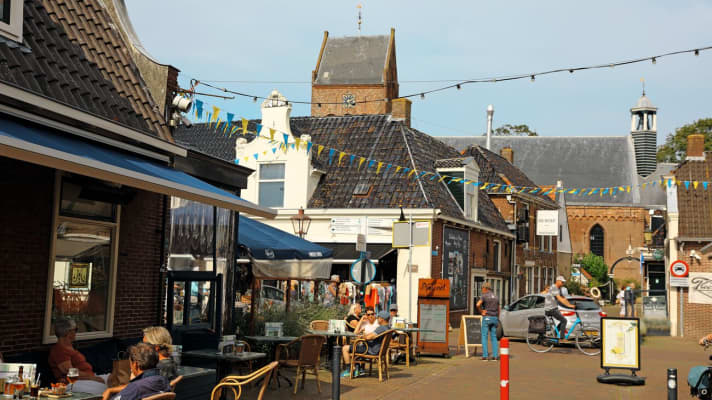
200 metres east of the harbour, the Prinses Margrietkanaal becomes the Van Starkenborghkanaal. We are back in the province of Groningen. Despite the name change, the canal remains as it was: a monotonous, functional waterway for commercial shipping. Zuidhorn is the only town worth mentioning along the route to Groningen. There is even a harbour at the branching Hoendiep. But it is closed, we read at the entrance to the Hoendiep. Good thing we had decided in favour of Stroobos.
The Van Starkenborghkanaal, which runs from west to east, is crossed by the Reitdiep in the Groningen suburb of Dorkwerd, which runs north-south here. We will return to our charter station in Zoutkamp in a northerly direction the next day. Today, however, Groningen is on the agenda. We enter the southernmost part of the Reitdiep via the Dorkwerd lock and head towards the Zuiderhaven. Six kilometres that are quite something: ten bridges that move as if by magic, residential boats alongside the banks. Despite the narrowness and abundance, relaxed and friendly skippers greeting us on the opposite course, magnificent views of the city's street canyons, cyclists, pedestrians and motorists waiting in front of bridge barriers. Here in Germany, it is inconceivable that central traffic arteries in a major city could be shut down for minutes on end by opening bridges in favour of recreational boating. And none of the many people waiting grumbles. That's the small difference that makes water sports so carefree and natural with our Dutch neighbours.
We find a cosy berth alongside the Sluiskade in the Zuiderhaven. Here we are just one kilometre from the city centre, the Grote Markt. Two of the city's most famous buildings, the Martinitoren and the town hall, are located here. On Tuesdays, Fridays and Saturdays, it becomes a lively market for fish, meat, vegetables, fruit and cheese. For those tired of shopping, there are numerous street cafés where you can relax.
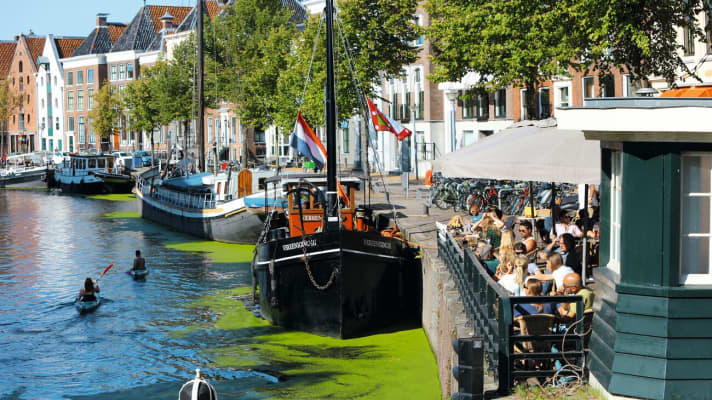
The fact that we were allowed to travel the southern section of the Reitdiep again the next day in the opposite direction confirms my old thesis that counter-courses always open up new insights and perspectives. So not: I've been here before, but: Oh, I haven't been here yet! The northern section of the Reitdiep from the crossing of the Van Starkenborghkanaal to Zoutkamp also offers new impressions: No more "wide view of flat land", but dykes that limit the view, at least for boaters who don't have a flybridge. And why the raised banks? Forgotten? Until 50 years ago, the Reitdiep was an arm of the North Sea and therefore exposed to the tides. So it was good that the brackish water was not constantly standing on the meadows at high tide. Finally, the small village of Garnwerd beckons with its cosy harbour, the Hanningh terrace café and the spectacular De Meeuw windmill on the dyke. Unfortunately, there is no more time.
Then we realise that there is still something to complain about in the end: This trip was far too short.
Author's note: Shortly after writing this report, skipper Manni passed away unexpectedly in March of this year. Our week together in the north of the Netherlands was his last cruise. The text remains as it was - in memory of a wonderful colleague.
Need more information? You can find the report "Nothing to complain about" as part of the Netherlands Journal with additional images and a service section in BOOTE issue 07/2022 - available from newsagents from 15 June 2022 or online directly in the Delius Klasing Shop.

